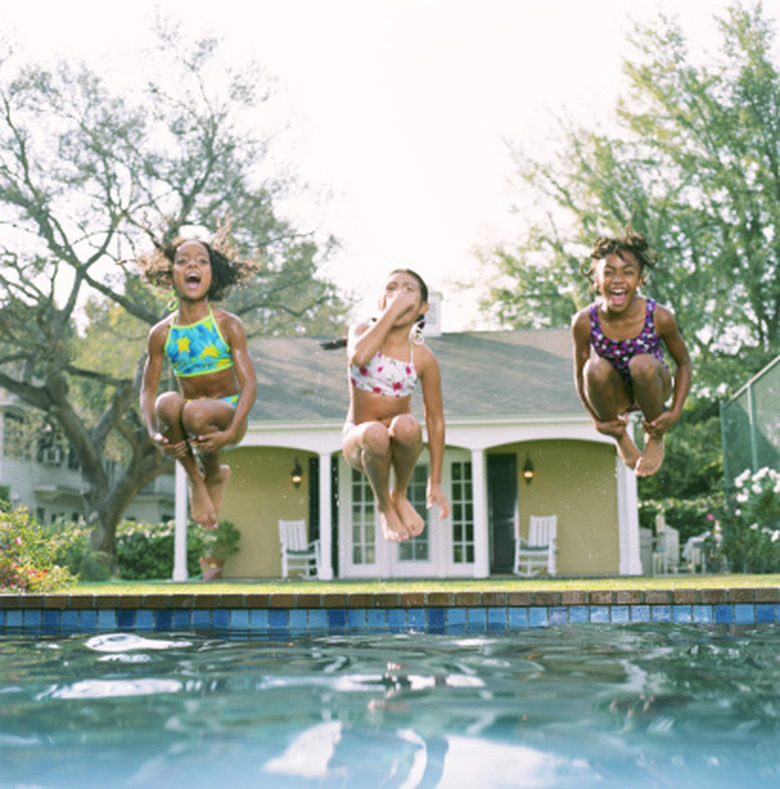Load Capacity For Pools
On hot summer days, everyone wants to go swimming. But wait! If you let everyone in the pool at the same time, the water might not be sanitary. Pool capacity regulations vary from state to state–and in some states they are only guidelines–but the ones specified by the Indiana State Department of Health are typical. They allow each person a minimum of 15 square feet in water deeper than 5 feet. In the shallow end, where water is less than 5 feet deep, each person should have a minimum of 20 square feet. People can huddle together more closely in spas and hot tubs, as long as everyone has 8 square feet of space in which to stretch out.
Calculate the Area of Your Pool
Calculate the Area of Your Pool
If you want to know whether your pool can accommodate the crowd you invited to your party, you need to calculate its surface area. For rectangular pools, make that calculation by multiplying the length of the pool by its width. For example, the surface area of a pool that's 80 feet long and 20 feet wide is 1,600 square feet.
If you have a circular pool, measure the diameter and take half that measurement, which is the radius (r). The area of the pool is πr2. Oval pools have two radii–a long one (r1) and a short one, (r2). The area is π r1 r2. To find the area of an irregularly shaped pool, divide it into rectangular or oval sections; calculate the area for each section, and add the areas together.
Calculate the Maximum Number of People
Calculate the Maximum Number of People
Before you calculate the pool capacity based on a minimum space of 20 square feet per person in 5-foot water and 15 square feet in deeper water, subtract 300 square feet from the total area of the pool for each diving board. The rest of the calculation is straightforward.
For example, suppose your pool has a total area of 1,600 square feet. You have one diving board, leaving 1,300 square feet for bathers. If the maximum depth of the pool is 5 feet, it can accommodate: 1,300 ÷ 20 = 65 people. If the entire pool is more than 5 feet deep, the capacity increases to: 1,300 ÷ 15 = 86 people. If only half of the pool is more than 5 feet deep, the capacity is: (650 ÷ 20) + (650 ÷ 15) = 76 people.
Check the pH and Chlorine Levels
Check the pH and Chlorine Levels
Even after showering, each bather brings a host of contaminants into the pool, including perspiration, natural body oils and even residual soap. These all get oxidized by the free chlorine in the pool, and the resulting chloramines do not have any sanitizing power. The contaminants introduced into the pool by swimmers also affect pH, and that can also lower the free chlorine concentration.
After a period of heavy pool use, it's important to first check pH and adjust it if necessary to bring it within a range from 7.2 to 7.6. Use muriatic acid or sodium bisulfate to lower the pH, and baking soda or soda ash to raise it.
After you've adjusted the pH, add chlorine as needed to bring the free chlorine concentration between 1 and 3 parts per million. If you're expecting to have more pool parties, shoot for a free chlorine concentration on the higher end of this scale to avoid having it fall too low when people are swimming. If the pool water has turned cloudy after a period of heavy use, it's a good idea to shock it by adding enough chlorine to raise the concentration to 10 ppm or more. Be sure to let the concentration fall to 5 ppm before anyone goes back in the pool.
One More Thing: Add Stabilizer
One More Thing: Add Stabilizer
Outdoor pools that receive a lot of sunshine need cyanuric acid (CYA)–a stabilizer–to prevent sunlight from quickly degrading the chlorine. Unless you chlorinate with dichlor tablets, which contain CYA, you have to add this manually. Ideally, the chlorine level should be about 7.5 percent of the CYA level. If the chlorine level is 2 ppm, this works out to a CYA level of around 30 ppm. As a rule of thumb, keep the CYA level between 20 and 500 ppm for good chlorine efficiency.
